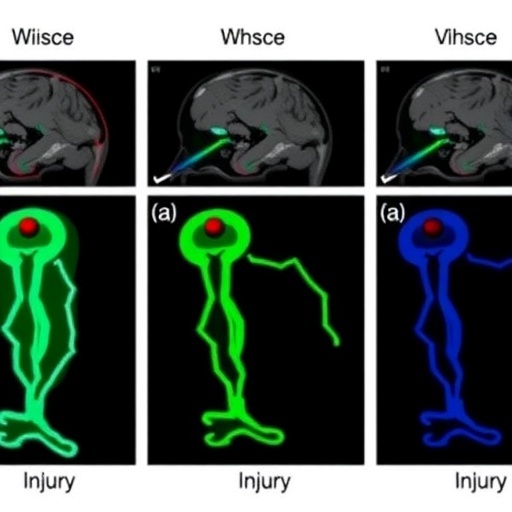
In the realm of forensic biomechanics and injury analysis, the ability to accurately simulate how the human body responds to trauma is a scientific holy grail. Recent advancements in computational modeling have allowed researchers to replicate injury-related motions with increasing precision. However, one of the persistent challenges has been adequately accounting for muscle activation—an essential biomechanical factor influencing how injuries occur and manifest. A groundbreaking study now confronts this issue head-on by combining experimental data obtained from subjects under general anesthesia with sophisticated computer simulations, marking a pivotal step forward in the fidelity of injury simulation.
Understanding the precise conditions under which injuries take place is crucial, not only for clinical diagnostics and treatment but also for the broader fields of automotive safety, legal medicine, and sports science. Most computational models to date have relied heavily on assumptions or simplifications when it comes to muscle activation. Muscles can drastically alter body kinematics during trauma, either by stiffening joints or influencing motion paths. The absence of accurate muscle activity data under trauma-like conditions introduces a margin of error that can mislead both researchers and practitioners. This study bypasses those limitations by introducing a novel experimental approach that captures muscle behavior decoupled from voluntary movement commands.
To achieve this, the researchers employed subjects under general anesthesia, allowing the muscles to be in a physiologically relaxed yet biomechanically relevant state. This unique setup provides an unprecedented window into passive biomechanical responses during controlled mechanical stimuli. Using this data, the team validated computational models that simulate injury-related kinematics, seamlessly integrating muscle activation parameters derived from the anesthesia-induced muscle relaxation context. The models demonstrated remarkable accuracy when predicting joint displacements and tissue strain, highlighting their utility in forensic reconstructions and injury prevention strategies.
.adsslot_mlGOFZhe6y{width:728px !important;height:90px !important;}
@media(max-width:1199px){ .adsslot_mlGOFZhe6y{width:468px !important;height:60px !important;}
}
@media(max-width:767px){ .adsslot_mlGOFZhe6y{width:320px !important;height:50px !important;}
}
ADVERTISEMENT
The integration of muscle activation data into injury simulations under such strictly controlled settings addresses a key gap in biomechanical modeling. Traditional in vivo studies have struggled to disentangle the complex interplay between reflexive muscle contractions and external forces applied during impact or sudden movement. By leveraging the muscle relaxation afforded by anesthesia, this research has isolated externally induced movements from internally generated muscular responses. This isolation sharpens the clarity of how passive tissue mechanics contribute to injury, allowing for a more faithful translation of real-world incidents into a computable framework.
One of the profound implications of this work lies in legal medicine. Forensic experts often rely on biomechanical reconstructions to determine whether injuries are consistent with specific accident scenarios. Previous models lacked the nuanced inputs of muscle activation, potentially skewing interpretations about the forces involved or the mechanisms causing injury. The validated models from this study enable more precise digital forensics, potentially distinguishing between accidental injuries, assaults, or falls with greater confidence. This newfound precision could improve the judicial process by grounding testimonies and evidence in scientifically robust simulations.
Moreover, the methods introduced here pave the way for a paradigm shift in injury biomechanics, transcending the traditional boundaries that have confined research largely to cadaveric studies or anesthetized animal models. Human subjects under general anesthesia represent a novel yet ethically challenging cohort that balances experimental control with physiological authenticity. By successfully navigating this ethical and methodological landscape, the study sets the stage for a new class of investigations aiming to decode the human body’s response to mechanical insults with unparalleled detail.
The technical backbone of the research involves advanced motion capture systems synchronized with electromagnetic and force sensors, enabling the precise quantification of joint angles, velocities, and accelerations in a controlled environment. Muscle electrical activity—or electromyography (EMG)—was carefully measured and suppressed due to anesthesia, enabling the isolation of passive tissue responses. These datasets were then input into finite element models that simulate the musculoskeletal system, tuned explicitly to replicate the observed kinematic profiles. Iterative validation ensured that the models not only fit experimental data but could reliably extrapolate to untested scenarios.
Beyond forensic and clinical applications, the findings have significant relevance for sports injury prevention and rehabilitation engineering. Athletes’ bodies operate near the limits of tissue tolerances during collision sports or high-impact activities. Accurate models incorporating muscle dynamics under passive and active states could revolutionize training regimens, protective gear design, and post-injury recovery protocols. For instance, wearables integrating real-time biomechanical feedback derived from such validated models could predict injury risk during games or workouts, prompting immediate countermeasures.
It is noteworthy that the study navigated intricate ethical considerations to involve human volunteers undergoing general anesthesia for data collection not related to surgical intervention. The rigorous approval processes and adherence to ethical guidelines underscore the researchers’ commitment to responsible innovation. Such pioneering approaches necessitate transparent discourse within both scientific and public domains to maintain trust and societal acceptance, especially when human subjects undergo experimental conditions that intersect with clinical practice.
The computational models refined through this work further open the door to personalized medicine approaches within trauma care. Individuals differ in muscle composition, joint flexibility, and tissue strength, all influencing injury outcomes. Future extensions of these validated models could incorporate patient-specific data from medical imaging or biomechanical assessments, offering tailored injury risk profiles or rehabilitation strategies. Such personalized simulations would also enhance training for surgeons and emergency responders, improving outcomes by anticipating complex biomechanical interactions during trauma.
This research also has a powerful potential to inform automotive safety technologies. Crash test dummies and surrogate models, while useful, often lack biofidelic muscle responses, leading to discrepancies in injury prediction. Integrating computational models with validated muscle activation parameters derived from this novel methodology could enhance the design of vehicles and safety systems, improving occupant protection during collisions. Regulatory agencies might adopt these improved models as part of safety standards, raising the bar for accident survivability and injury mitigation.
The meticulous experimental setup showcased in the study exemplifies interdisciplinary collaboration, uniting anesthesiologists, biomechanical engineers, computer scientists, and forensic experts. This collaborative framework underscores how modern science thrives at the intersection of diverse expertise, pushing boundaries to address complex real-world problems. The study’s success serves as a call to expand such cross-disciplinary teams, harnessing complementary skills and perspectives to accelerate innovations in injury biomechanics.
Looking ahead, this research is poised to catalyze a broader transformation in forensic and medical biomechanics. As computational power grows and machine learning techniques mature, integrating high-fidelity experimental data—such as those obtained under anesthesia—will become standard practice. Artificial intelligence could soon augment these simulations, identifying subtle patterns or predicting injury responses under varying conditions with minimal human bias. These advancements promise to render injury analysis more objective, reproducible, and actionable.
Finally, the public impact of such research cannot be understated. By enhancing the accuracy of injury simulations, this work offers hope not only for courts seeking truth but also for those striving to reduce the burden of trauma worldwide. Safer cars, smarter sports gear, improved clinical interventions, and informed legal decisions are all tangible outcomes that stem from this sophisticated blend of experimental rigor and computational innovation. In an era increasingly reliant on digital twins and virtual testing, the validation of injury-related computational models marks a milestone in the quest to understand the human body’s responses under extreme conditions.
Subject of Research: Validation of computational models simulating injury-related kinematics incorporating muscle activation using experimental data obtained under general anesthesia.
Article Title: Validation of computational models simulating injury-related kinematics with muscle activation – obtaining data under general anaesthesia.
Article References:
Siebler, L., Thaler, S., Muehlbauer, J. et al. Validation of computational models simulating injury-related kinematics with muscle activation – obtaining data under general anaesthesia. Int J Legal Med (2025). https://doi.org/10.1007/s00414-025-03577-0
Image Credits: AI Generated
Tags: automotive safety researchbiomechanics of trauma responseclinical diagnostics for injuriescomputational modeling advancementsexperimental data in injury modelingforensic biomechanicsgeneral anesthesia effects on muscle dataimproving injury simulation fidelityinjury simulation accuracylegal medicine applicationsmuscle activation in traumasports science injury analysis





